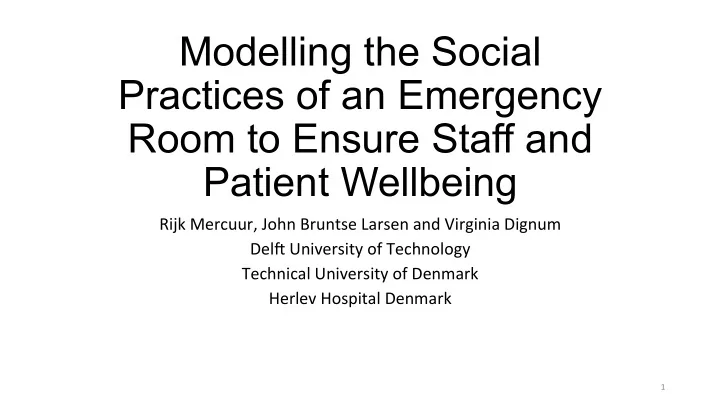

Modelling the Social Practices of an Emergency Room to Ensure Staff and Patient Wellbeing Rijk Mercuur, John Bruntse Larsen and Virginia Dignum Del; University of Technology Technical University of Denmark Herlev Hospital Denmark 1
My doctor didn’t look at me during my last visit 2
The emergency room suffers from social problems 3
Patients and staff take up more time, become unsatisfied and counterproductive. 4
Patient and Staff are healthier, cooperative and are more satisfied 5
The emergency room suffers from social problems … how to keep track of this complex system? 6
Our formal model of the social ER can help management in finding social problems 3 OWL Model inference using model 2 UML 4 Model 1 Social find social problem ER 7
Modelling the ER is split in three task: a meta- model, model and modelling desirable social properties UML UML UML UML Social ProperSes Meta- Domain Model Model Model = 1 Desirable Social Social Social Social ER ER ProperSes in ER 8
Our model aims to capture the social dimension by using the concept of social practices UML 1 ER 9
The Social Practice Agent (SoPrA) meta- model focuses on activities as the core of a social system UML 1 ER 10
The social practice of acute treatment is captured in an activity tree UML 1 ER 11
SoPrA models associations with these activities such as human values UML 1 ER 12
SoPrA models associations with these activities such as human values UML 1 ER 13
SoPrA models associations with these activities such as human values UML 1 ER 14
One might associate the value of security and health to contact an ER UML 1 ER 15
Agents belief certain activities UML 1 ER 16
Patient1 beliefs (one view one) contact_ER UML 1 ER 17
Doctor beliefs a different view on contact_ER UML 1 ER 18
Agent differ in what human values they adhere to UML 1 ER 19
A patient adheres to the value security and health UML 1 ER 20
Modelling the ER is split in three task: a meta- model, model and modelling desirable social properties UML UML UML UML Social ProperSes Meta- Domain Model Model Model = 1 Desirable Social Social Social Social ER ER ProperSes in ER 21
Based on empirical observations we formulated social properties management could desire • The staff understand the needs of the pa0ents. • A head nurse can cover some of the necessary tasks of the secretary. • The staff can help each other out, because they know the equipment the others need. UML 1 ER 22
The desirable properties are modelled in terms of the SoPrA meta-model The staff understand the needs of the paSents. The staff and paSents belief the same perspecSve on an acSvity, for all acSviSes which promote values that the paSent has 23
We can express possible models that satisfy this property The doctor has a different view on contact_ER The doctor has the same view on contact_ER UML 1 ER 24
Our formal model of the social ER can help management in finding social problems 3 OWL Model inference using model 2 UML 4 Model 1 Social find social problem ER 25
To be able to make inferences we formalize the model in OWL OWL Model 2 UML Model 26
To be able to make inferences we formalize the model in OWL using Protege OWL OWL SPARQL Model Meta-Model Queries (Abox) OWL (Tbox) Model = 2 UML UML UML UML MetaModel Social Model Model ProperSes 27
By using OWL we can state rules about the relation of concepts: e.g. the inheritance of values belief(?ag, ?pp), promotedValue(?pp, ?val), partOf(?pp, ?p), partOf(?pc, ?c), implementaSonOf(?sc, ?p), belief(?ag, ?pc), Personal(?pp), AcSvity(?p), AcSvity(?c), partOf(?sc, ?c), Personal(?pc), Shared(?sc) -> promotedValue(?pc, ?val) 28
Modelling the social properties in SPARQL-queries The staff and paSents belief the same perspecSve on an acSvity, for all acSviSes which promote values that the paSent has SELECT ?agent ?value ?acSvity WHERE { ?agent a:belief ?acSvity. a:PaSent a:HasValue ?value. ?acSvity a:promotedValue ?value} 29
Our formal model of the social ER can help management in finding social problems 3 OWL Model inference using model 2 UML 4 Model 1 Social find social problem ER 30
Using SPARQL you can query the database and get back a table of possible instances that satisfy the query SELECT ?agent ?value ?valuedAcSvity WHERE { ?agent a:belief ? valuedAcSvity. a:PaSent a:HasValue ?value. ? valuedAcSvity a:promotedValue ?value} ?agent ?valuedAc0vity paSent1 Contact_ER1 secretary1 Contact_ER2 doctor1 Contact_ER1 31
Our formal model of the social ER can help management in finding social problems 3 OWL Model inference using model 2 UML 4 Model 1 Social find social problem ER 32
Using the result we infer that the desirable social property is not satisfied in this case ?agent ?valuedAc0vity paSent1 Contact_ER1 secretary1 Contact_ER2 doctor1 Contact_ER1 The staff understand the needs of the paSents. 33
The resulting findings can be used as a hypotheses on where to direct intention of management to solve social problems in the ER 3 2 4 1
Future Work • To cross-validate our model we need to ground both the model as well as check the resulSng conclusions against empirical data • We focused on a rough empirical grounding from observaSons on the ER at Herlev Hospital Denmark, extend this by more rigorous emprical work • Process Mining • Protocols • Interviews 35
SoPrA differs from other social agent frameworks by capturing the social dimension in shared action assocations The staff can help each other out, because they know the equipment the others need OperA Consumat MAIA 36
Recommend
More recommend